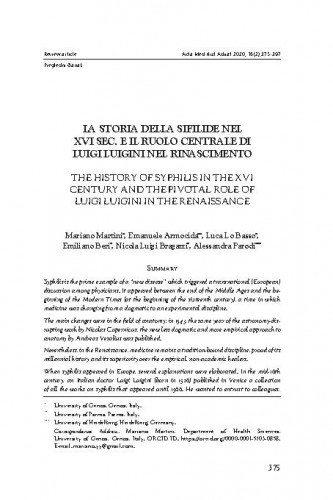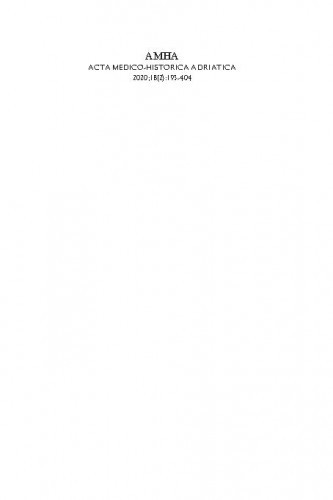Syphilis is the prime example of a “new disease” which triggered a transnational (European) discussion among physicians. It appeared between the end of the Middle Ages and the beginning of the Modern Times (at the beginning of the sixteenth century), a time in which medicine was changing from a dogmatic to an experimental discipline. The main changes were in the field of anatomy: in 1543, the same year of the astronomy-disrupting work by Nicolas Copernicus, the new less dogmatic and more empirical approach to anatomy by Andreas Vesalius was published. Nevertheless, in the Renaissance, medicine remains a tradition-bound discipline, proud of its millennial history and its superiority over the empirical, non-academic healers. When syphilis appeared in Europe, several explanations were elaborated. In the mid-16th century, an Italian doctor Luigi Luigini (born in 1526) published in Venice a collection of all the works on syphilis that appeared until 1566. He wanted to entrust to colleagues, contemporary and future, a compendium of all that was known about the “new” disease (the Latin term Novus means both “new” and “strange”). According to the most authors of the collection, the disease is in fact “new” and “strange”. Some authors of the collection find it impossible that authorities like Hippocrates and Galen overlooked it. Luigini’s work shows the authors’ effort to absorb syphilis in the corpus of academic medicine and affirm the authority of academic physicians against the empirical healers.; Sifilis je važan primjer “nove bolesti” koja je pokrenula transnacionalnu (europsku) raspravu među liječnicima. Bolest se pojavila između kraja srednjeg vijeka i početka modernog doba (početkom 16. stoljeća), u vrijeme u kojem se medicina iz dogmatske mijenjala u eksperimentalnu disciplinu. Glavne promjene dogodile su se na polju anatomije: u 1543., istoj godini u kojoj se pojavio rad Nikole Kopernika, koji je promijenio zakone astronomije, objavljen je novi, manje dogmatični i više empirijski pristup anatomiji u radu Andreasa Vesaliusa. Ipak, u renesansi medicina ostaje disciplina vezana uz tradiciju, ponosna na svoju tisućljetnu povijest i svoju superiornost nad empirijskim, neakademskim iscjeliteljima. Kada se sifilis pojavio u Europi, nekoliko je objašnjenja detaljno izloženo. Sredinom 16. stoljeća, talijanski liječnik Luigi Luigini (rođen 1526.) objavio je u Veneciji zbirku svih djela o sifilisu koja su se pojavila do 1566. Želio je prenijeti svojim suvremenicima i budućim kolegama sažetak svega što je bilo poznato o “novoj bolesti” (latinski pojam Novus znači i “novi” i “čudan”). Prema većini autora zbirke, bolest je “nova” i “čudna”. Neki autori čiji se radovi pojavljuju u zbirci smatraju nemogućim da su najveći autoriteti, poput Hipokrata i Galena, previdjeli tu bolest. Luiginijevo djelo pokazuje napor autora da uvrste sifilis u korpus akademske medicine i potvrde autoritet akademskih liječnika nasuprot empirijskih iscjelitelja.
La storia della sifilide nel XVI sec.e il ruolo centrale di Luigi Luigini nel rinascimento = The history of syphilis in the XVI century and the pivotal role of Luigi Luigini in the renaissance / Mariano Martini, Emanuele Armocida, Luca Lo Basso, Emiliano Beri, Nicola Luigi Bragazzi, Alessandra Parodi.
Sažetak

 Acta medico-historica Adriatica : 18,2(2020) / glavni urednik, editor-in-chief Igor Eterović.
Acta medico-historica Adriatica : 18,2(2020) / glavni urednik, editor-in-chief Igor Eterović.